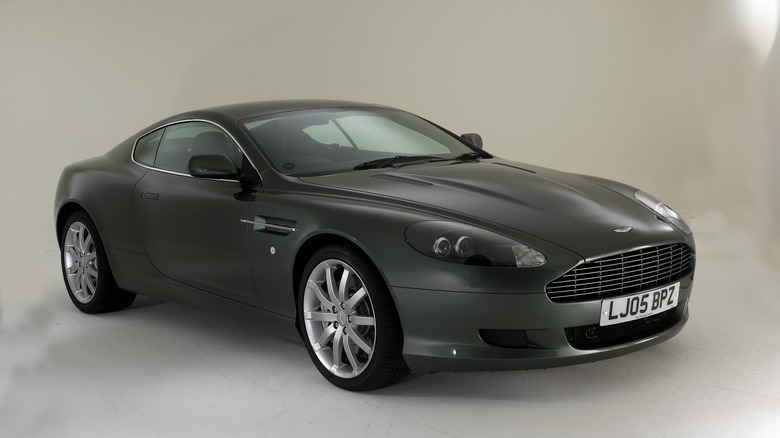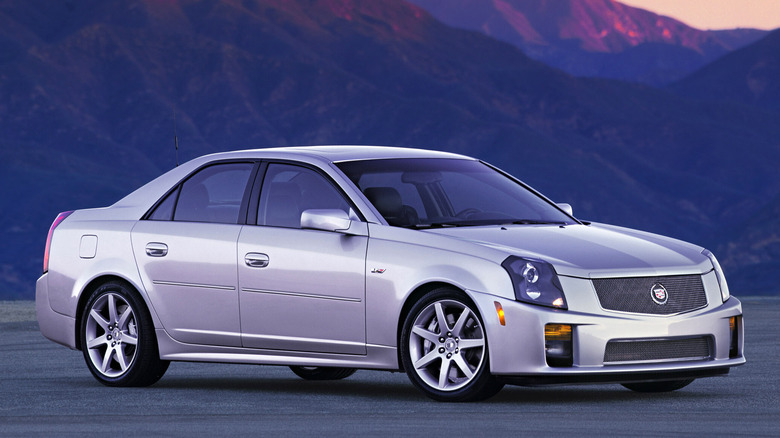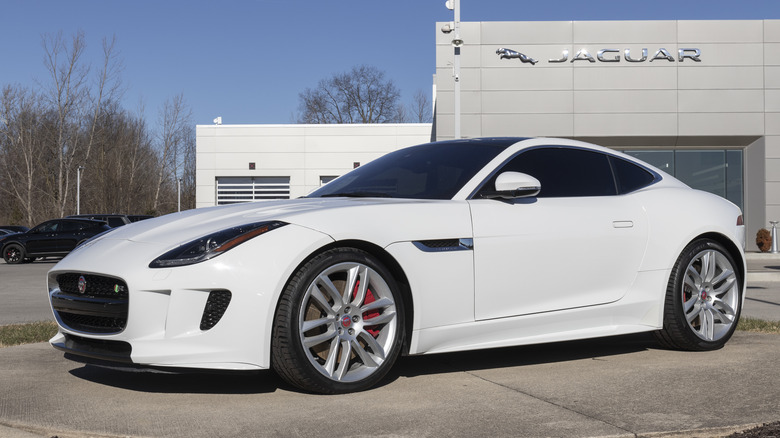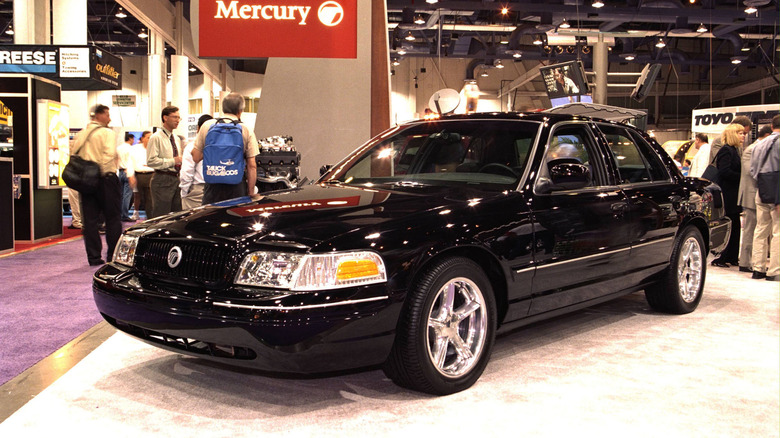10 Performance Cars We Think Are Surprisingly Undervalued
As we approach the twilight years of the internal combustion engine, we see many different sports and performance car types slowly fizzle out. The days of the manual, RWD performance car that's all about driver involvement and holds back on the electronic helpers are numbered. While electric cars and recent advancements in chassis and drivetrain setups are all very impressive, things used to be a lot simpler and, for a lot of people, a lot more exciting.
Thanks to this, the value of old-fashioned performance cars of yore has increased. A lot of them were a dime a dozen just a decade ago, but now, everyone is wishing they bought one when it was new. Despite many older performance cars becoming pipe dreams in the present day, there are still quite a few on the used market that are surprisingly undervalued and worth picking up before they end up costing five annual salaries.
After a look through the aggregator Classic.com, we've singled out some of the most tempting options as of the time of publishing.
Aston Martin DB9
In the early 90s, the Aston Martin DB7 saved the British automaker from almost certain extinction, and it cemented them as one of the major players in the world of the luxury GT car. The DB9 evolved the foundations laid by the DB7, being built on an all-new platform and making the incredible Aston Martin V12 the de facto engine option. Sure, it might have shared a few switches and buttons with contemporary Volvos, but it was the ultimate expression of an Aston Martin.
When the DB9 was new, it was very pricey, as expected. It was also one of the only V12 Aston Martins to be available with a manual transmission, although most people ended up going for the automatic transmission and its finicky Touchtronic gear selector. To no one's surprise, manual DB9s are monstrously expensive on the used market, and Aston Martin depreciation didn't spare the automatic cars. On average, a DB9 will set you back a little less than $42,000. A full-service and lower mileage is always preferred, but even those will cost you about the same as a fully loaded Toyota Highlander.
Cadillac CTS-V (First Generation)
For the longest time, Cadillac had a reputation for attracting a specific clientele. This sort of buyer was, more often than not, over the age of 60. That all changed in the early 2000s, as Caddy got serious about taking the fight to the all-conquering Germans. Even though it was the underdog in this battle, Cadillac aimed at quite a sensitive area: the luxury performance sedan.
The first-generation Cadillac CTS also brought along the first-ever Cadillac CTS-V. V was to Cadillac what AMG was to Mercedes. The more dressed-up exterior hid some pretty significant changes. For the initial run, the CTS-V was equipped with a 5.7-liter naturally-aspirated V8, dubbed the LS6. A healthy 405 horsepower was dispatched to the rear wheels through, and only through, a six-speed manual transmission.
As expected, the CTS-V also received further upgrades, including larger brakes, heavily uprated suspension components, and a multi-mode traction control system that would allow the driver to get the tail out without the risk of danger. Despite all of these qualities, the CTS-V1 remains one of the biggest performance car bargains of today, with a going rate of less than $20,000. Pick one up before the price doubles.
Jaguar F-Type
After multiple promises of a new RWD sports car, Jaguar finally delivered in 2012 (model year 2014) with the brilliant F-Type. So many things were right about it, and it gave the Porsche Cayman and Boxster something to worry about. The F-Type has been around for over a decade now, and unfortunately, Jaguar is about to consign the F-Type to the history books as it prepares to go all-electric. In the meantime, thanks to the used market not being kind to the F-Type, people can now enjoy this excellent machine affordably.
Over the F-Type's production run, we saw countless derivatives. There was the Coupe version, an SVR version with the supercharged V8 turned up to 11, and Jaguar even offered a manual transmission and AWD, though the manual wasn't particularly well received. Eventually, a four-cylinder also joined the lineup. No matter which version of the F-Type you look at on the used market, you can find one for relatively little cash.
Remember, this is a used Jaguar, so reliability is a definite concern. The more expensive ones with detailed service records are worth more of a look than the ultra-cheap ones, otherwise, you might end up with a Hoovies Garage situation.
Audi R8 (First Generation)
Mr. Stark's ride is here. Audi hadn't experimented with supercars and sports cars before this, but when the R8 came along, people were wondering why they hadn't done it sooner. The formula was quite simple: A mid-engine layout, the 4.2-liter FSI V8 was taken from the RS4, and it was paired up with a six-speed manual transmission, or a jerky R-tronic automatic and Quattro AWD.
Eventually, the R8 would also receive a version of the Lamborghini Gallardo's 5.2-liter V10, and about two dozen special editions, as well as a facelift in the early 2010s. The R8 is one of the most recent casualties of the modern automotive industry, with the last production R8 rolling off the line in 2024. The newer R8 is very impressive in its own right, but people have started to fawn over the original V8-powered version a lot more in recent years.
The naturally-aspirated V8 and its 414 horsepower were very balanced, and paired with the gated manual transmission and its 1950s microphone shifter, the original R8 offered the kind of experience that is practically impossible to find in modern supercars. Unfortunately, the manual versions have already started the uphill charge towards six figures, so make sure to buy one before they're worth more than most decent houses.
Mercury Marauder
Ford's Panther platform has gotten quite popular with a certain group of car enthusiasts, for a few good reasons. You can pick up a former fleet Crown Victoria for pocket change, and for the money you get one of the most durable sedans that money can buy, not to mention plenty of headroom for mods, and the ability to scare Nissan Altima drivers on the highway. While the Crown Vic won the hearts of fleet buyers, and the related Lincoln Town Car was all about the bingo club members, there was a third, more fun way to have a Panther vehicle: the Mercury Marauder.
Taking its name from a handful of full-size sedans from the 60s, the Marauder was a genuine performance sedan, and it could be considered a factory sleeper in several ways. Its grunt came from the same 4.6-liter Modular V8 that its siblings used, but here, it put out a pretty healthy 300 horsepower. That was Mustang levels of horsepower in a completely unassuming full-size sedan. If it weren't for the black paint scheme, you could easily mistake it for a cab, or a police cruiser.
The chassis also got some appropriate tuning, thanks to Tokico monotube shocks, and much larger disc brakes. With a 0-60 time of just over 7 seconds, you might not be able to scare any Porsches, but the unassuming Marauder could go to town on most Honda Civics and Toyota Echos of that era. This factory sleeper can now be found for, on average, around $20,000.
Ferrari 612 Scaglietti
Throughout the 90s, Ferrari offered the 456 for the family-focused Ferrari buyer. While the 456, one of many underrated Ferrari models, does have a cult following, the same couldn't be said of the 612 Scaglietti, the replacement for the 456 that arrived in 2004. It took up the same place in Ferrari's lineup: the front-engine V12 four-seater. The problem with the 612 wasn't the powertrain, as the 5.8-liter V12 under the hood was appropriate for such a vehicle. The problem was, rather predictably, the styling.
Pininfarina was still in charge of the exterior, but for the 612, they made some pretty questionable decisions. The front end and its tiny headlights were one thing, but they also managed to somewhat mess up the proportions, with too much wheelbase and rear overhang. This made the 612 Scaglietti the unloved Ferrari, not just at the time, but even today.
Today, the 612 Scaglietti's appearance that only a mother could love has done it a massive favor: it's one of the only ways to have a used Ferrari for less than $100,000. That includes meticulously kept examples with full-service histories and very nice option packages. For those looking for V12 Ferrari action for five figures, plus the ability to take the family along, the 612 Scaglietti is a pretty good bet.
Dodge Viper (Third Generation)
In the 90s, a skunkworks team at Chrysler put together what can only be described as a more modern take on the AC Cobra. A V10 engine co-engineered by Lamborghini, six-lug wheels, and a compact body penned by Tom Gale all came together to create the Viper. The original Viper had 400 horsepower from a colossal 8.0-liter V10, RWD, a six-speed manual transmission, and little else.
Things got a little more civilized by the third generation Viper in the early 2000s, also known by the internal name ZB I. By this time, Dodge started to reintroduce a few creature comforts, like air conditioning. Even then, the Viper was not for the laid-back driver, as with all that power and very few electronic nannies, it could easily spin the wheels in third gear. You had to be awake to handle a Viper.
While Viper fans fawn over the ACR and the 90s iterations of the Viper, the third-generation cars have been neglected. This means a much lower price of admission, around $50,000 for super-low mileage ones, or around $40,000 for a higher mileage example. You're still getting the majority of the Viper experience, remember. It's a pretty solid bargain.
Ford Fiesta ST
After decades of splitting their model lineups between North America and the rest of the world, Ford finally unified the lineups for every market. This gave Europe the Edge SUV, while North America got the Fiesta and Focus, virtually unchanged from their European counterparts. The return of the Fiesta to North America also paved the way for one of the most effortlessly fun FWD performance cars of all time: the Fiesta ST.
For the US and Canada, the Fiesta ST came only as a five-door hatchback, but the styling remained identical other than that. Anyway, the styling isn't the main point of the Fiesta ST, but rather the way it can put an endless smile on the driver's face. Under the hood was a turbocharged 1.6-liter I4 making 197 horsepower and a pretty meaty 202 lb-ft of torque.
That power went, unsurprisingly, to the front wheels through a mandatory six-speed manual transmission. The ST sport suspension and larger wheels ensured the amazing handling was in check, while the thick Recaro seats stopped you from sliding everywhere. With how much fun the Fiesta ST offers, it's quite necessary. The Fiesta ST was a pretty good bargain when new, but lest you're a rear-wheel drive evangelist, it's a no-brainer. A decent Fiesta ST will set you back $15,000 or less.
Buy one.
Nissan 370Z
The Nissan Z car lineage traces its roots back to the 240Z of the 1960s, still one of the most desirable Japanese cars. From the 60s to the present day, the Z car went through quite a few notable changes, such as the switch from I6 to V6 power. V6 power became de facto, displacing 3.0 liters in the 300ZX, 3.5 liters in the wind instrument band 350Z, and 3.7 liters in the 370Z.
With those increases in engine capacity also came exponential increases in power. The 370Z put out 332 horsepower from its VQ37, which all went to the rear wheels through your choice of either a six-speed manual transmission or the unloved seven-speed torque converter automatic. The design was more evolutionary, but the 370Z is a rather handsome machine, appearing overall sharper and more focused than the more rounded 350Z that came before.
These days, the 370Z remains a fantastic V6-powered, RWD bargain on the used market. A used 370Z will set you back, on average, $25,000. The manual cars demand a slight premium that is still generally affordable. The 370Z is also the last Z car without forced induction, so there's a pretty big rev range to be enjoyed.
Audi TT
When the original Audi TT concept car dropped in 1995, nobody was ready for that incredible, ageless styling. Despite Audi not having plans to build a production car initially, the positive reception drove them to do it anyway, with little to no changes. The styling was so ahead of its time, Audi devised entirely new welding techniques to make it all fit together. Today, the TT is an icon, as evidenced by the Audi TT Final Edition.
It's unlikely we'll ever see another car quite like the Audi TT, which is why older examples have increased in value. Third-generation and second-generation cars, yes, but first-generation cars are especially desirable. Once Audi sorted out their lethal slipperiness, it resulted in a fantastically sorted coupe with a great powertrain and equally exciting handling, especially when paired up with AWD.
Today, you can pick up a decent first-generation TT for, on average, around $12,000. The most desirable ones carry the manual transmission and the iconic baseball glove leather interior, so those will command a slight premium. As the first-generation TT was mostly manual throughout the production run, it won't be difficult to sort one of those at least.
This curiosity is worthy of consideration, so give it a shot before everyone wants one.










